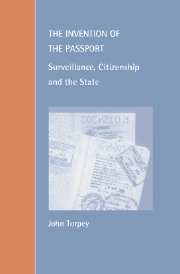Book contents
- Frontmatter
- Contents
- Acknowledgments
- Introduction
- 1 Coming and Going: On the State Monopolization of the Legitimate “Means of Movement”
- 2 “Argus of the Patrie”: The Passport Question in the French Revolution
- 3 Sweeping Out Augeas's Stable: The Nineteenth-Century Trend Toward Freedom of Movement
- 4 Toward the “Crustacean Type of Nation”: The Proliferation of Identification Documents From the Late Nineteenth Century to the First World War
- 5 From National to Postnational? Passports and Constraints on Movement from the Interwar to the Postwar Era
- Conclusion: A Typology of “Papers”
- Notes
- References
- Index
4 - Toward the “Crustacean Type of Nation”: The Proliferation of Identification Documents From the Late Nineteenth Century to the First World War
Published online by Cambridge University Press: 24 August 2009
- Frontmatter
- Contents
- Acknowledgments
- Introduction
- 1 Coming and Going: On the State Monopolization of the Legitimate “Means of Movement”
- 2 “Argus of the Patrie”: The Passport Question in the French Revolution
- 3 Sweeping Out Augeas's Stable: The Nineteenth-Century Trend Toward Freedom of Movement
- 4 Toward the “Crustacean Type of Nation”: The Proliferation of Identification Documents From the Late Nineteenth Century to the First World War
- 5 From National to Postnational? Passports and Constraints on Movement from the Interwar to the Postwar Era
- Conclusion: A Typology of “Papers”
- Notes
- References
- Index
Summary
Despite the generally liberal attitude toward freedom of movement that carried the day in Europe during the late nineteenth century, governments became increasingly oriented to making distinctions between their own citizens/subjects and others, a distinction that could be made only on the basis of documents. At first this concern was typically directed at specific groups of undesirable outsiders, but it gradually spread and became a general trait of ever more socially integrated “national” societies. Thus despite the fact that the period from the late nineteenth century until the First World War has been frequently viewed as an unexampled era of free movement in the modern age, the period also saw the spread of various kinds of identification documents that sharpened the line between national and alien and thereby contributed to what has aptly been called the “naturalization of nativism.”
In the United States, for example, which had been more or less open to free movement for the white population, the development of passports and identification documents grew dramatically toward the end of the nineteenth century. As elsewhere, the ultimate result would be to promote the institutionalization of documentary controls designed to regulate movement and to distinguish clearly between nationals and others. As the preferred destination of enormous numbers of migrants from around the world during this period, the posture of the United States played a crucial role in the shift toward more rigorous and bureaucratic mechanisms for regulating movement.
- Type
- Chapter
- Information
- The Invention of the PassportSurveillance, Citizenship and the State, pp. 93 - 121Publisher: Cambridge University PressPrint publication year: 1999



